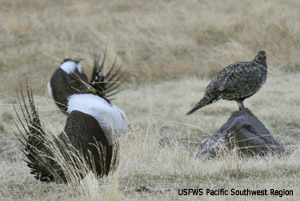Sage-Grouse Habitat Requirements
Sage-grouse depend on a variety of semiarid shrub-grassland (or shrub steppe) habitats throughout their life cycle and specifically require sagebrush for cover and forage. They are very loyal to their seasonal nesting, breeding, brood rearing, and wintering areas, which makes it hard for them to adapt to changes in their environment.
Leks and Nesting Areas
 Sage-grouse are most known for their courtship displays on small clearings called leks. During breeding season males court females on these relatively bare areas surrounded by sagebrush and grasslands. Sagebrush and grasslands surrounding leks are required for cover during breeding season as well as nesting habitat. High quality nesting areas are generally comprised of sagebrush with an understory of native grasses and forbs, a variety of cover is required to conceal nests and also provide insects to sustain the adult sage-grouse.
Sage-grouse are most known for their courtship displays on small clearings called leks. During breeding season males court females on these relatively bare areas surrounded by sagebrush and grasslands. Sagebrush and grasslands surrounding leks are required for cover during breeding season as well as nesting habitat. High quality nesting areas are generally comprised of sagebrush with an understory of native grasses and forbs, a variety of cover is required to conceal nests and also provide insects to sustain the adult sage-grouse.
Brood-rearing and Summer
After the sage-grouse hatch, the brood-rearing period begins. During brood-rearing many sage-grouse gradually move to moist areas, such as streambeds and wet meadows. These wetter areas are required through the summer because they provide sage-grouse and chicks with essential insects and forbs. As wet areas decrease over the summer, sage-grouse return to sagebrush habitats and their diet shifts entirely to sagebrush.
Sagebrush Facts:
- Sagebrush is considered one of the most imperiled ecosystems in North America.
- Sagebrush can live up to 150 years.
- After fire or destruction, sagebrush requires decades for full recovery.
Juniper control improves habitat for sage-grouse
Western juniper trees have been encroaching on upland and meadow habitat in the Owyhee Mountains for more than 50 years. Juniper encroachment causes problems for the Greater Sage-grouse, a candidate species for listing under the Endangered Species Act, and degrades habitat for wildlife and livestock grazing. A new method called "juniper mastication" has been applied on more than 5,000 acres of private land in Owyhee County, and the results appear promising. The Natural Resources Conservation Service (NRCS) provides cost-share funds for the control work. The Nature Conservancy and others are monitoring the results.